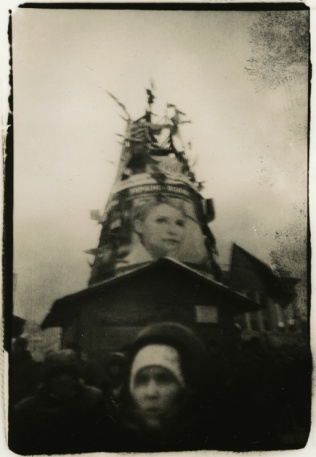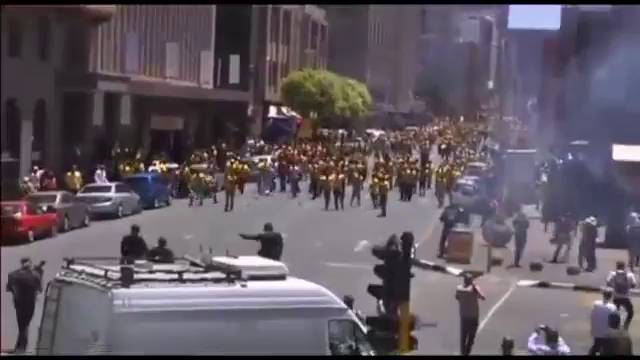Το έσχατο σημείο της αμοιβαίας συνεπαγωγής των τάξεων είναι όταν το
προλεταριάτο κυριεύει τα μέσα παραγωγής. Τα κυριεύει, αλλά δεν μπορεί να τα
ιδιοποιηθεί. Η ιδιοποίηση από το προλεταριάτο δεν είναι ιδιοποίηση, επειδή
πραγματοποιείται μόνο μέσω της ίδιας του της κατάργησης ως τάξης.
«Η αυτοοργάνωση είναι η πρώτη πράξη της επανάστασης, η συνέχεια
πραγματοποιείται εναντίον της»
Η κυρίευση των στοιχείων του κεφαλαίου: ιδιοποίηση ή κομμουνιστικοποίηση;
Το ζήτημα της κομμουνιστικοποίησης έγκειται στην υπέρβαση από το προλετα-
ριάτο, ή μάλλον από τους προλετάριους, της υπεράσπισης της κατάστασής τους,
άρα και της αμοιβαίας συνεπαγωγής τους με το κεφάλαιο, μέσα σε μια δρα-
στηριότητα κυρίευσης του κεφαλαίου – δραστηριότητα που δεν είναι κοινωνι-
κοποίηση, δηλαδή τρόπος διαχείρισης της οικονομίας, αλλά συγκρότηση μιας
κοινότητας ατόμων η οποία είναι κατά άμεσο τρόπο τα συστατικά της στοιχεία.
Οι κοινωνίες, δηλαδή οι κοινότητες που κυριαρχούνται και εκπροσωπούνται
από μια τάξη, συγκροτούν την ενότητα των ατόμων που είναι μέλη τους, αλλά τα
άτομα είναι μέλη των κοινωνιών μόνο σαν μέσα άτομα μιας τάξης· τα μοναδικά
άτομα δεν έχουν κοινωνική ύπαρξη. Η κομμουνιστικοποίηση πραγματοποιείται
μέσω της κυρίευσης των μέσων διαβίωσης, επικοινωνίας, μεταφοράς και παρα-
γωγής με τη στενή έννοια. Η κομμουνιστικοποίηση των σχέσεων, η συγκρό-
τηση της ανθρώπινης κοινότητας, ο κομμουνισμός, πραγματοποιείται για τον
αγώνα κατά του κεφαλαίου, μέσα σε αυτόν και μέσω αυτού. Στον αγώνα αυτόν
δεν μπορούμε να αντιπαραθέτουμε την κυρίευση των υλικών μέσων και τον
μετασχηματισμό των προλετάριων σε άτομα που είναι κοινωνικά απευθείας και
δίχως μεσολάβηση (άμεσα κοινωνικά άτομα): πρόκειται για μιαν αξεχώριστη
δραστηριότητα, και την ταύτιση αυτή την ορίζει η σημερινή μορφή της αντί-
φασης προλεταριάτου/κεφαλαίου. Η ριζική διαφορά με την κοινωνικοποίηση
είναι ότι δεν πρόκειται για αλλαγή του ιδιοκτησιακού καθεστώτος των υλικών
μέσων. Στην κομμουνιστικοποίηση δεν υπάρχει ιδιοποίηση των αγαθών από
κανένα όργανο (κράτος, κομμούνα, ή ακόμα συμβούλιο) που θα εκπροσωπούσε
τους προλετάριους, θα κυριαρχούσε πάνω τους στη δράση της απαλλοτρίωσης
του κεφαλαίου κι έτσι θα τη μετέτρεπε σε ιδιοποίηση. Η αλλαγή του ιδιοκτησι-
ακού καθεστώτος είναι συγκρότηση μιας νέας μορφής οικονομίας, του σοσια-
λισμού, έστω κι αν θα έπαιρνε το όνομα της αλληλέγγυας οικονομίας. Όταν ο
σοσιαλισμός ήταν πραγματικά εφικτός, αυτό ανέβαλλε τον κομμουνισμό για το
απώτατο μέλλον. Επρόκειτο στην πραγματικότητα για την αδυναμία του σοσια-
λισμού να είναι ό,τι ισχυριζόταν πως είναι: μεταβατικό στάδιο προς τον κομμου-
νισμό. Ο σοσιαλισμός ήταν τελικά η αντεπανάσταση που προσιδίαζε στη μόνη
πραγματική επανάσταση της περιόδου. Η κομμουνιστικοποίηση δεν συγκροτεί
οικονομία· χρησιμοποιεί τα πάντα, αλλά δεν έχει άλλο σκοπό από τον ίδιο τον
εαυτό της. Η κομμουνιστικοποίηση δεν είναι αγώνας για τον κομμουνισμό, εί-
ναι ο κομμουνισμός που συγκροτείται ενάντια στο κεφάλαιο.
Η συνύφανση της κομμουνιστικοποίησης και της κοινωνικοποίησης
Ενώ η δράση της κομμουνιστικοποίησης αποτελεί κατάληξη της ταξικής πάλης
μέσα στην επαναστατική κρίση, η ίδια η δράση της κυρίευσης μπορεί, όπως
είδαμε, να είναι είτε κομμουνιστικοποίηση είτε κοινωνικοποίηση. Κάθε δράση
τέτοιου τύπου μπορεί να πάρει τη μια ή την άλλη μορφή· όλα εξαρτώνται από τη
δυναμική, όλα εξαρτώνται από το διαρκώς μετασχηματιζόμενο πλαίσιο, δηλαδή
όλα εξαρτώνται από τον αγώνα εναντίον του κεφαλαίου, ο οποίος είτε βαθαίνει
και επεκτείνεται είτε επιβραδύνεται και πολύ γρήγορα παρακμάζει. Όλα εξαρ-
τώνται επίσης από τον αγώνα που διεξάγεται μέσα στον αγώνα εναντίον του
κεφαλαίου. Η συγκρότηση του κομμουνισμού συνυφαίνεται με τη συγκρότηση
μιας έσχατης μορφής της καπιταλιστικής κοινωνικοοικονομικής εναλλακτικής
λύσης. Η τάση για τη συγκρότηση οργάνων που θα επιδιώκουν να μετατρέψουν
την κυρίευση των υλικών μέσων σε οικονομική και πολιτική κοινωνικοποίη-
ση θα είναι συνεχής μέχρι την πλήρη κομμουνιστικοποίηση. Αυτή η μόνιμη
παρουσία, μέσα στο κίνημα της επανάστασης, μιας τροχοπέδης που μπορεί να
χρησιμοποιηθεί από την καπιταλιστική αντεπανάσταση εκφράζει το γεγονός ότι
θα υπάρχει μέχρι τέλους μια διάσταση επιβεβαίωσης και απελευθέρωσης της
εργασίας, γιατί το κίνημα της επανάστασης είναι και παραμένει κίνημα της τάξης
της εργασίας ακόμα και μέσα στην υπέρβαση των δραστηριοτήτων ως εργασίας.
Η διατήρηση αυτής της επιβεβαίωσης παράγεται από τη συνεχιζόμενη ύπαρξη
του κεφαλαίου. Όσο το κεφάλαιο υπάρχει απέναντι στο προλεταριάτο, ακόμα και
στο προλεταριάτο που τείνει να το καταργήσει κι επομένως να αυτοκαταργηθεί
και το ίδιο, το προλεταριάτο διατηρεί μια θετικότητα. Αυτή η θετικότητα της ερ-
γασίας, έστω κι αν δεν επιβεβαιώνεται πια από το κεφάλαιο, επανενεργοποιείται
μέσα στην επαναστατική διεργασία επειδή, μέσα σε αυτήν, η κοινωνική αναπα-
ραγωγή εξαρτάται από τη δράση των προλετάριων.
Το παρελθόν των επαναστάσεων μας δείχνει ολοφάνερα ότι «η κόκκινη σημαία
μπορεί να υψωθεί ενάντια στην κόκκινη σημαία» μέχρι να καταφθάσουν τα
στρατεύματα του κράτους και του παρακράτους
Το κεφάλαιο «δεν θα διστάσει» να διακηρύξει ξανά ότι η εργασία είναι «η μόνη
παραγωγική δραστηριότητα», προκειμένου να σταματήσει το κίνημα της κατάρ-
γησής του και να το καθυποτάξει μόλις μπορέσει. Η μόνη υπέρβαση αυτής της
διάστασης έγκειται στη νίκη της κομμουνιστικοποίησης, που είναι η συντελε-
σμένη κατάργηση της καπιταλιστικής τάξης και του προλεταριάτου. Η υπέρ-
βαση αυτής της αντεπανάστασης δεν πρόκειται ποτέ να είναι γαλήνια, δεν θα
συντελείται πάντα «στην πορεία», δεν θα είναι μια γνήσια και πιο ταχύρρυθμη
εκδοχή του «μαρασμού του κράτους» που προβλεπόταν από τον σοσιαλισμό.
Κάθε κρατική ή παρακρατική μορφή θα κάνει πάντοτε το παν για να διατηρηθεί,
εν ονόματι μάλιστα της ανάγκης για την απώτερη εξαφάνισή της! Αυτή η αρτη-
ριοσκλήρωση και αυτή η διατήρηση δεν είναι «αντεπαναστατικές τάσεις μέσα
στην επανάσταση», αλλά είναι η αντεπανάσταση. Η καπιταλιστική αντεπανάστα-
ση απέναντι στην επανάσταση.
Ο κομμουνισμός δεν αγωνίζεται εναντίον της δημοκρατίας, αλλά η αντεπανάσταση
αυτοαναγορεύεται δημοκρατική
Επικαλούμενη και η ίδια την κατάργηση των τάξεων, η ριζοσπαστική δημοκρα-
τία θα κάνει το παν για να διατηρήσει ή να αποκαταστήσει δομές εκλογής εκ-
προσώπων, τις οποίες θα χαρακτηρίζει αναγκαίες προκειμένου να αποφευχθεί
ο σχηματισμός ενός νέου διευθυντικού στρώματος, αυτοεγκατεστημένου και
ανεξέλεγκτου. Η συγκρότηση του κομμουνισμού διαπλέκεται με τη συγκρότηση
μιας ύστατης μορφής σοσιαλισμού, έστω κι αν το κίνημα που τη στήριζε –το
εργατικό κίνημα– έχει εξαφανιστεί οριστικά.
Ο αγώνας για να «λογικευτούν» οι φράξιες του προλεταριάτου που επιδί-
δονται με μεγαλύτερο ζήλο στην απαλλοτρίωση του κεφαλαίου θα είναι ακόμα
βιαιότερος στον βαθμό που θα εμφανίζεται σαν υπεράσπιση της δημοκρατικής
επανάστασης, η οποία αρνείται να επιτρέψει σε «μειοψηφίες» να θέσουν σε κίν-
δυνο τις κατακτήσεις της πλειοψηφίας.

 Conakry — At least two people including a trainee policeman were killed and 33 wounded as residents angry at power shortages rioted in the Guinean capital Conakry on Tuesday, security sources and witnesses told AFP.
Conakry — At least two people including a trainee policeman were killed and 33 wounded as residents angry at power shortages rioted in the Guinean capital Conakry on Tuesday, security sources and witnesses told AFP.

